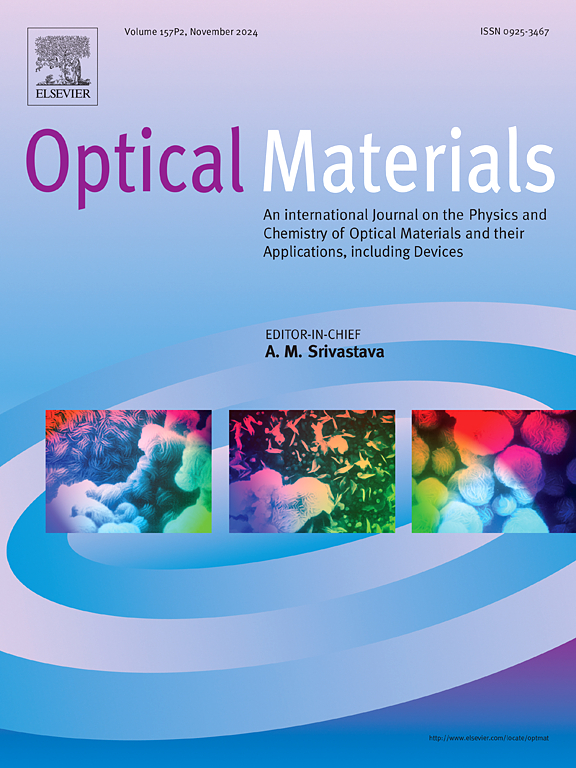Er3+/Yb3+ 共掺杂铌酸镧的宽范围发射:针对生物光子学应用的温度和激发相关性发光研究
IF 3.8
3区 材料科学
Q2 MATERIALS SCIENCE, MULTIDISCIPLINARY
引用次数: 0
摘要
我们采用溶胶-凝胶法合成了 Er3+、Yb3+ 共掺杂的铌酸镧样品,并研究了它们在不同激发光源下的发光特性,旨在应用于生物光子学领域。样品呈结晶状,主要由正方晶形的 La3NbO7 组成,其次形成单斜晶形的 LaNbO4。在 980 纳米和 1550 纳米的激发下,我们用肉眼验证了近红外到可见光的上转换;分别在绿色和红色区域发射。X 射线激发显示了蓝色区域的普遍发射,这归因于晶格中 NbO43- 基团的发光,以及可见光范围内的 Er3+ 发射。所有样品都具有很高的相对热灵敏度(高于 1.32 % K-1),在 243 至 293 K 之间的重复性高于 97 %。根据所研究的发光特性,本文制备的样品是一种多功能材料,具有作为闪烁体、光学标记、光动力疗法能量转换器和纳米温度计的广泛应用潜力。本文章由计算机程序翻译,如有差异,请以英文原文为准。
Wide-range emission of Er3+/Yb3+ co-doped lanthanum niobates: A study of temperature and excitation-dependent luminescence aiming at applications in Biophotonics
We have synthesized Er3+,Yb3+ co-doped lanthanum niobate samples by a sol–gel route and investigated their luminescent properties under different excitation sources aiming at applications in Biophotonics. The samples were crystalline and composed primarily of orthorhombic La3NbO7 with secondary formation of monoclinic LaNbO4. We verified NIR-to-visible upconversion with the naked eye under excitation at 980 and 1550 nm; emission in the green and red regions prevailed, respectively. X-ray excitation revealed prevalent emission in the blue region, attributed to the luminescence of NbO43− groups in the lattice, as well as Er3+ emissions in the visible range. All the samples presented high relative thermal sensitivity (above 1.32 % K−1) and repeatability above 97 % between 243 and 293 K. Based on the investigated luminescent properties, the samples prepared herein are versatile materials with a wide range of potential applications as scintillators, optical markers, energy converters for photodynamic therapy, and nanothermometers.
求助全文
通过发布文献求助,成功后即可免费获取论文全文。
去求助
来源期刊

Optical Materials
工程技术-材料科学:综合
CiteScore
6.60
自引率
12.80%
发文量
1265
审稿时长
38 days
期刊介绍:
Optical Materials has an open access mirror journal Optical Materials: X, sharing the same aims and scope, editorial team, submission system and rigorous peer review.
The purpose of Optical Materials is to provide a means of communication and technology transfer between researchers who are interested in materials for potential device applications. The journal publishes original papers and review articles on the design, synthesis, characterisation and applications of optical materials.
OPTICAL MATERIALS focuses on:
• Optical Properties of Material Systems;
• The Materials Aspects of Optical Phenomena;
• The Materials Aspects of Devices and Applications.
Authors can submit separate research elements describing their data to Data in Brief and methods to Methods X.
 求助内容:
求助内容: 应助结果提醒方式:
应助结果提醒方式:


